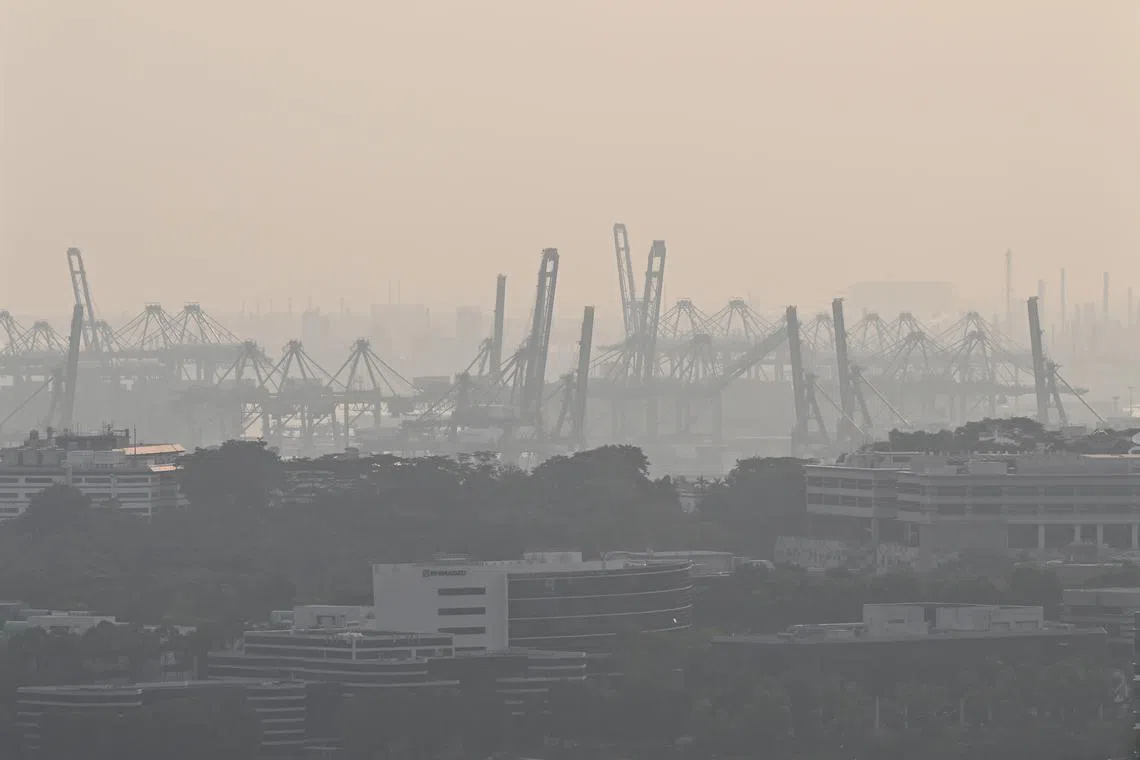Haze severity in S’pore will depend on wind direction, even as Indonesia hot spots increase
Sign up now: Get ST's newsletters delivered to your inbox

Haze situation in Singapore on Oct 5, 2023. The haze is unlikely to be as severe as previously seen in 2013 and 2015.
ST PHOTO: SHINTARO TAY
Follow topic:
SINGAPORE - The wind direction would determine the severity of transboundary haze conditions in Singapore, even as the number of hot spots in Indonesia increases, said experts.
According to the National Environment Agency (NEA), air quality is at unhealthy levels in southern and central parts of Sumatra, as well as in South and Central Kalimantan, with dense smoke haze coming from fires in West and East Kalimantan.
Associate Professor Steve Yim, principal investigator at the Earth Observatory of Singapore at Nanyang Technological University, has observed an increasing number of hot spots since Sept 24,
But he said the number of hot spots is not yet comparable to that seen during the more serious haze episodes in 2015 and 2019.
Freelance atmospheric scientist Erik Velasco said that predominant south-east winds are currently bringing slight haze from fires in southern Sumatra and Kalimantan.
“Contrary to Kuala Lumpur, we have been slightly out of the plume trajectory. If winds shift and start blowing from the south-west, plumes from Jambi (West Sumatra) and Riau (Sumatra) will reach Singapore, and will probably bring a more intense haze,” he added.
But the haze is unlikely to be as severe as previously seen in 2013 and 2015. Dr Velasco said changes in wind direction could bring about more particulate matter known as PM2.5, which would result in moderate or severe haze.
“If that happens, my guess is that it would be for a short period of time, from hours to one or two days at most,” he said, based on wind patterns in the past few weeks.
PM2.5 refers to fine particles – usually airborne – that are 2.5 microns or smaller and can be lodged deep in the lungs, posing severe health risks. For comparison, a strand of human hair is about 70 microns thick.
The Pollutant Standards Index (PSI) is computed based on a 24-hour average of concentration levels of PM2.5, among other pollutants.
Hotter and drier weather with the onset of El Nino in the second half of 2023 will be exacerbated by the positive Indian Ocean Dipole, another climate phenomenon that brings about drier weather.
NEA expects the dry weather to persist over the next fortnight, with short showers over Singapore. Official daily haze advisories would be provided, should the agency anticipate the 24-hour PSI to enter the “unhealthy” range.
In South-east Asia, such weather causes dry, flammable Indonesian peatlands to become more susceptible to fires.
Professor Matthias Roth of the Department of Geography at the National University of Singapore said Singapore will likely continue to be affected by smoke haze from fires, particularly from South and Central Sumatra, until the north-east monsoon season in November or December, when the direction of prevailing winds would come from the north instead, blowing smoke haze away from Singapore.

